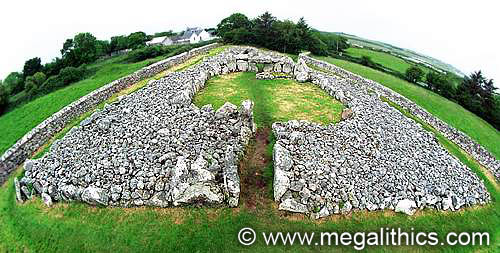
 |
|
More Pics |
|
|
Panoramas |
|
|
|
Infrared |
|
| G 71925 54552 (GPS 359min), gallery lintel. | Size 21m x ~48m (Pub.) |
| Visited June 2002 |
A massively impressive monument today after restoration, Creevykeel was an obscure site when first recorded as an antiquity in the OS Name Book of 1909. The record of that time describes the site as "three ancient graves situated about 100yards SE of Mrs. McGown's shop", as can be seen from the photo above, there was much more to Creevykeel than was apparent at that time. An excavation by Hencken in1939 revealed a huge Court Cairn containing a large gallery and three subsidiary chambers.
The cairn is trapezoidal and is about 21m across the "front" at the SE, the length is uncertain as the "rear" of the cairn at the NW has been destroyed, but surviving revetment indicates it was at least 48m long. The cairn was retained by dry stone revetment which was built directly on the ground surface, virtually all of this has gone, but in some places surviving sections still reach up to about 1.5m high. There are two short sections, one at the NE, and also one midway along the southern side, where there are double walls of revetment separated by about 1m. In addition to these small sections, the entire SE "front" end of the cairn has double walls 4m apart, almost as though the front of the cairn had been lengthened by the addition of an extension. There are also short (2-3m), runs of upright slabs set outside of the revetment on the north and south sides, their significance is unclear.
The entrance to the court is an orthostat-lined, paved passage, 1m wide and 4.5m long, set in the middle of the slightly concave SE end of the cairn. The court itself is a 15m x 9m oval also lined with orthostats, these stones are not set in socket holes, like the revetment they rest directly on the ground surface. Both the court and passage orthostats have dry stone inter-fill in places, a technique which is also seen in the walls of gallery chambers themselves. The court lining stones vary in height, averaging 1m, but become tallest as they approach the gallery entrance, reaching a height of 2m, they may also have had increased height around the entrance passage. A gap of 3.5m was found in the court lining stones at the south, and another smaller gap had been made at the north when a kiln was built there in early Christian times. Near the centre of the court space was a large shallow sand-filled pit delimited by bands of stones.
The gallery is entered between two huge jamb stones which bear the massive re-erected lintel stone, the area in front of the entrance was paved. The gallery is about 9m long and is divided into two chambers by a second pair of jamb stones, the front chamber runs for about 4.5m and the rear about 3.5m. The gallery width is about 3m, but it tapers in towards the rear where it ends at the huge back slab. The back stone is gabled, as are the intermediate jamb stones, all shaped to support the original corbelled roof of the chamber, traces of this corbelling can still be seen at the rear of the chamber.
Past the gallery to the NW are the remains of three subsidiary chambers with lateral entrances, two on the north, and one on the south side of the cairn. The northern chambers are heavily damaged so their original structure is unknown, but the southern chamber fared much better. This chamber has a short well defined entrance passage about 2m long and 1m wide opening into an orthostat lined chamber measuring 2.5m x 2m.
The cairn has undergone extensive restoration, the entire rear cairn section, much of the northern chambers, and NE cairn corner are all reconstructions, the southern gap in the court wall has also been closed. Interestingly, the restorers chose to retain the early Christian gap in the court wall and the kiln remains.
Finds from the site included undecorated Neolithic pottery, decorated Early Bronze Age pottery, stone tools, a stone bead, and two clay balls. Given the complexity of the monument, there was surprisingly little evidence of funerary activity, this was limited to small pieces of cremated bone found in pits in both gallery chambers.
Today Creevykeel is an atmospheric and very accessible monument to visit, it is only metres from the main Bundoran to Sligo road and has ample parking. This is not without its downside however, as during the summer months you must be prepared to share the site with a steady stream of totally uninterested tourists.